
Snowboards are boards where the user places both feet, usually secured, to the same board. The board itself is wider than most skis, with the ability to glide on snow. Snowboards widths are between 6 and 12 inches or 15 to 30 centimeters. Snowboards are differentiated from monoskis by the stance of the user. In monoskiing, the user stands with feet inline with direction of travel, whereas in snowboarding, users stand with feet transverse to the longitude of the board. Users of such equipment may be referred to as snowboarders. Commercial snowboards generally require extra equipment such as bindings and special boots which help secure both feet of a snowboarder, who generally ride in an upright position. These types of boards are commonly used by people at ski hills, mountains, backcountry, or resorts for leisure, entertainment, and competitive purposes in the activity called snowboarding.
A ski is a narrow strip of semi-rigid material worn underfoot to glide over snow. Substantially longer than they are wide, and characteristically employed in pairs, skis are attached to ski boots with ski bindings, with either a free, lockable, or partially secured heel. For climbing slopes, ski skins can be attached at the base of the ski.
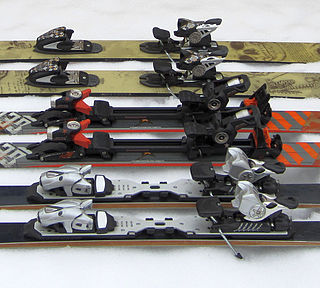
A ski binding is a device that connects a ski boot to the ski. Before the 1933 invention of ski lifts, skiers went uphill and down and cross-country on the same gear. As ski lifts became more prevalent, skis—and their bindings—became increasingly specialized, differentiated between alpine (downhill) and Nordic styles of skiing. Until the point of divergence in the mid-20th century, bindings held the toe of a flexible, leather boot against the ski and allowed the heel to rise off the ski, typically with a form of strap or cable around the heel.
Kristi Leskinen is an American freestyle skier. At Winter X Games IX, Leskinen won a bronze medal in the Women's Superpipe. Kristi Leskinen was the first woman to ever pull off a rodeo 720—two rotations with her head pointed towards the earth. She was named one of the Twenty Greatest Adventure Sport Athletes of today by Faces Magazine in fall of 2005. She appeared on the cover of Powder magazine's Photo Annual in 2004.
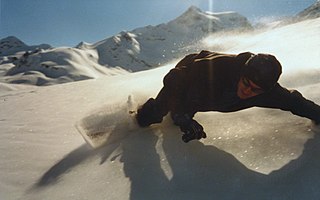
Freeriding is a style of snowboarding or skiing performed on natural, un-groomed terrain, without a set course, goals or rules. It evolved throughout the sport's formative early years as a contrary response to the highly regimented style of ski competition prevalent at the time. Snowboarders primarily refer to freeriding as backcountry, sidecountry, or off-piste snowboarding, and sometimes big mountain or extreme riding.

Freeskiing, or new school skiing, is a specific type of alpine skiing, which involves tricks, jumps, and terrain park features, such as rails, boxes, jibs, or other obstacles. This form of skiing resulted from the growth of snowboarding combined with the progression of freestyle skiing. "Newschoolers", or those who specifically ski in this style, as opposed to traditional freestylers, freeriders, big mountain skiers, and racers, are often found in terrain parks, which are designed specifically for tricks.

Ski geometry is the shape of the ski. Described in the direction of travel, the front of the ski, typically pointed or rounded, is the tip, the middle is the waist and the rear is the tail. Skis have four aspects that define their basic performance: length, width, sidecut and camber. Skis also differ in more minor ways to address certain niche roles. For instance, skis for moguls are much softer to absorb shocks from the quick and sharp turns of the moguls and skis for powder are much wider to provide more "float" in deeper, softer snow.
Marker International is a German manufacturing company of equipment for winter sports established in 1952 and headquartered in Straubing, Lower Bavaria. Founded by Hannes Marker, the company is known for pioneering releasable binding technology. Marker's first model, the Duplex was followed in 1953 by the Simplex toe binding which was a huge success in the 1950s. New models introduced in the 1980s were major competitors on the alpine racing circuit.

Candide Thovex is a French professional skier, filmmaker and entrepreneur. He is known for his creative freestyle skiing movies and professional accomplishments. His first notable jump was at Chad's Gap, a massive transfer jump of 120 feet (37 m) from take-off to landing over a 40 feet (12 m) deep gully in Alta, Utah, US. His point of view videos routinely go viral on the internet and are viewed by tens of millions. He is widely considered to be one of the best freeskiers in the history of the sport.
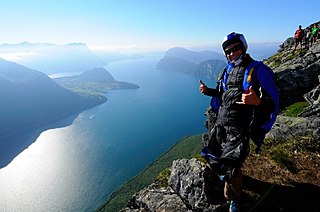
Shane McConkey was a professional skier and BASE jumper. He was born in Vancouver, British Columbia and eventually based himself in Olympic Valley, California. Due to an itinerant childhood, he never identified with a single place, but he was said to have come from Boulder, Colorado. It was from here that he started his professional skiing career. He did so after dropping out of the University of Colorado Boulder to pursue his dreams.
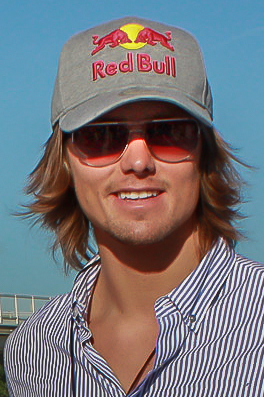
Jon Anders Olsson is a professional freeskier and alpine ski racer from Sweden. Born in Mora, Olsson started his career as a ski racer but at age 16 he switched his race skis for twin tips and quit ski racing. Eight years later, after a 50 000 SEK (US$5826.22) bet with fellow skier Jens Byggmark, Olsson started ski racing again with the goal of the bets being to make it to the Olympics in 2014. He now competes in both freestyle and ski racing. Olsson is known for his invention of several new double flips, including a D-spin 720 into a flatspin 540, a switch double rodeo 1080, a double flatspin 900, and a switch cork 720 to flatspin 540.
4FRNT Skis is an independent brand of alpine ski equipment that helped to pioneer the development of the freeskiing movement. 4FRNT introduced the model of a rider-owned and operated ski company to the sport.

Charles Gagnier is a Canadian freeskier, best known for inventing the Octograb in 2006.
Joe Tyler - born 1 April 1982 in Halifax, West Yorkshire is a Freestyle skier. He has appeared as a Free rider in various ski movies and skied in the first London Freeze Festival at Battersea Power Station's 2008 snow event. He appeared on Turkish media in 2007 skiing in Erzurum, Turkey. He has spent 2009 living in Mayrhofen in March he travelled to Kashmir with photographer Camilla Stoddart for some extreme skiing(see New Zealand AdventureFall magazine issue 154 & Fall Line Skiing magazine November 2009.) He also travelled to Georgia - ERISTOFF originates from the wild and untamed landscape of Georgia originally named Virshan by the Persians meaning the country of the wolf. Eristoff took professional skier Joe Tyler to the Caucasus mountains of Georgia to sample the slopes and the local hospitality. More information can be found on http://www.metacafe.com/watch/3419799/eristoff_vodka_ski_film_joe_tyler/ He is also in the latest 2009 Run Jump Fly production ski movie "Falling Skies" https://web.archive.org/web/20091027042211/http://www.downdays.eu/en/whitepaper/falling-skies-download

The International Freesports Film Festival (iF3) is a film Festival dedicated to screening and rewarding freeskiing and snowboarding movies. Held annually at the end of October in Montreal, iF3 was created in 2007 by Félix Rioux, Doug Bishop and Jean-Francis Durocher. As it premieres the best movies of the past season, iF3 has been referred to as the "Cannes of the ski world!" by ESPN and won Quebec action sports Gala Maestro's event of the year in 2010.

Line Skis, commonly shortened to Line or stylized as LINE, is a new school skis company owned by K2 Sports. Line Skis was founded by Jason Levinthal in 1995 to produce short, twin-tipped skis for freestyle skiers, and has since moved to produce full-length freeskis.
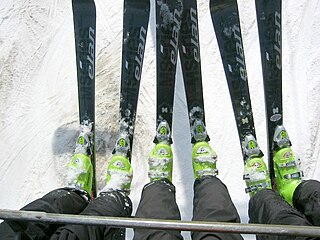
The SCX, for "SideCut eXtreme", was an alpine ski introduced by Elan in the winter of 1993/4. Skis before the SCX had almost always used a shape that was slightly curved inward on the sides, typically by 7 millimetres (0.28 in) compared to a straight line running from tip to tail. The SCX was designed with over 22 millimetres (0.87 in) "sidecut", producing a wasp-waisted ski unlike anything on the market.
Michelle Parker is a pro-skier from Truckee, California, US. She started skiing in her home resort Squaw Valley Ski Resort. At the age of 15, she started dedicating herself to freeskiing. She has subsequently competed in the U.S. Freeskiing open, X-games and Red Bull Cold Rush.
"Sick" Rick Armstrong is a professional skier, freeskiing pioneer, mountaineer, paraglider, businessman and serial entrepreneur based in Jackson Hole, Wyoming. He was a pioneering guide in the early years of Alaska Heli-skiing while working as a lead guide for Valdez Heli-skiing and Doug Coombs as chronicled in the 2007 feature film Steep. He was a member of the ultra-elite group of skiers called the Jackson Hole Airforce who transformed skiing in the 1990s and 2000s. He is known for having skied unskied lines such as his first and unrepeated massive drop into the left side of the notorious Corbet's Couloir at Jackson Hole Mountain Resort. He was the first person to have both skied and snowboarded the Grand Teton in Teton National Park. He has many first ski descents in China, Alaska, Europe, Antarctica, South America, and South Georgia Island. He was an athlete in the 1998 and 1999 Winter X-Games in Crested Butte. He was Awarded sponsorships by The North Face and Salomon. He also became an athlete talent scout for The North Face building a world-class ski team by discovering soon to be ski stars such as Sage-Cattabriga-Alosa, Ingrid Backstrom, Kitt Deslauries, Griffen Post, and Hillary Nelson. Armstrong was also a co-founder of the Teton Gravity Research film production company. He served on the board of directors for Intrawest from 2012 to 2017.
This glossary of skiing and snowboarding terms is a list of definitions of terms and jargon used in skiing, snowboarding, and related winter sports.













